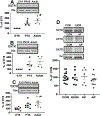Developing Brain Glucose Transporters, Serotonin, Serotonin Transporter, and Oxytocin Receptor Expression in Response to Early-Life Hypocaloric and Hypercaloric Dietary, and Air Pollutant Exposures
- PMID: 33774619
- PMCID: PMC8344089
- DOI: 10.1159/000514709
Developing Brain Glucose Transporters, Serotonin, Serotonin Transporter, and Oxytocin Receptor Expression in Response to Early-Life Hypocaloric and Hypercaloric Dietary, and Air Pollutant Exposures
Abstract
Perturbed maternal diet and prenatal exposure to air pollution (AP) affect the fetal brain, predisposing to postnatal neurobehavioral disorders. Glucose transporters (GLUTs) are key in fueling neurotransmission; deficiency of the neuronal isoform GLUT3 culminates in autism spectrum disorders. Along with the different neurotransmitters, serotonin (5-HT) and oxytocin (OXT) are critical for the development of neural connectivity. Serotonin transporter (SERT) modulates synaptic 5-HT levels, while the OXT receptor (OXTR) mediates OXT action. We hypothesized that perturbed brain GLUT1/GLUT3 regulated 5-HT-SERT imbalance, which serves as a contributing factor to postnatal neuropsychiatric phenotypes, with OXT/OXTR providing a counterbalance. Employing maternal diet restriction (intrauterine growth restriction [IUGR]), high-fat (HF) dietary modifications, and prenatal exposure to simulated AP, fetal (E19) murine brain 5-HT was assessed by ELISA with SERT and OXTR being localized by immunohistochemistry and measured by quantitative Western blot analysis. IUGR with lower head weights led to a 48% reduction in male and female fetal brain GLUT3 with no change in GLUT1, when compared to age- and sex-matched controls, with no significant change in OXTR. In addition, a ∼50% (p = 0.005) decrease in 5-HT and SERT concentrations was displayed in fetal IUGR brains. In contrast, despite emergence of microcephaly, exposure to a maternal HF diet or AP caused no significant changes. We conclude that in the IUGR during fetal brain development, reduced GLUT3 is associated with an imbalanced 5-HT-SERT axis. We speculate that these early changes may set the stage for altering the 5HT-SERT neural axis with postnatal emergence of associated neurodevelopmental disorders.
Keywords: Environmental exposure; Fetal brain; Intrauterine growth restriction; Neurodevelopment; Neurotransmitters.
© 2021 The Author(s) Published by S. Karger AG, Basel.
Conflict of interest statement
Conflict of Interest Statement
The authors declare no competing financial interests.
Figures








Similar articles
-
Neurodevelopment Is Dependent on Maternal Diet: Placenta and Brain Glucose Transporters GLUT1 and GLUT3.Nutrients. 2024 Jul 21;16(14):2363. doi: 10.3390/nu16142363. Nutrients. 2024. PMID: 39064806 Free PMC article. Review.
-
Brain serotonin and serotonin transporter expression in male and female postnatal rat offspring in response to perturbed early life dietary exposures.Front Neurosci. 2024 Mar 21;18:1363094. doi: 10.3389/fnins.2024.1363094. eCollection 2024. Front Neurosci. 2024. PMID: 38576870 Free PMC article.
-
Maternal undernutrition during late gestation-induced intrauterine growth restriction in the rat is associated with impaired placental GLUT3 expression, but does not correlate with endogenous corticosterone levels.J Endocrinol. 2002 Jul;174(1):37-43. doi: 10.1677/joe.0.1740037. J Endocrinol. 2002. PMID: 12098661
-
Placental glucose transporter 3 (GLUT3) is up-regulated in human pregnancies complicated by late-onset intrauterine growth restriction.Placenta. 2013 Nov;34(11):1072-8. doi: 10.1016/j.placenta.2013.08.010. Epub 2013 Aug 28. Placenta. 2013. PMID: 24011442 Free PMC article.
-
Ontogeny and regulation of the serotonin transporter: providing insights into human disorders.Pharmacol Ther. 2011 Jul;131(1):61-79. doi: 10.1016/j.pharmthera.2011.03.013. Epub 2011 Apr 5. Pharmacol Ther. 2011. PMID: 21447358 Free PMC article. Review.
Cited by
-
Neurodevelopment Is Dependent on Maternal Diet: Placenta and Brain Glucose Transporters GLUT1 and GLUT3.Nutrients. 2024 Jul 21;16(14):2363. doi: 10.3390/nu16142363. Nutrients. 2024. PMID: 39064806 Free PMC article. Review.
-
Molecular pathways in placental-fetal development and disruption.Mol Cell Endocrinol. 2024 Feb 1;581:112075. doi: 10.1016/j.mce.2023.112075. Epub 2023 Oct 16. Mol Cell Endocrinol. 2024. PMID: 37852527 Free PMC article. Review.
-
Characterization of placental endocrine function and fetal brain development in a mouse model of small for gestational age.Front Endocrinol (Lausanne). 2023 Feb 10;14:1116770. doi: 10.3389/fendo.2023.1116770. eCollection 2023. Front Endocrinol (Lausanne). 2023. PMID: 36843585 Free PMC article.
-
Brain serotonin and serotonin transporter expression in male and female postnatal rat offspring in response to perturbed early life dietary exposures.Front Neurosci. 2024 Mar 21;18:1363094. doi: 10.3389/fnins.2024.1363094. eCollection 2024. Front Neurosci. 2024. PMID: 38576870 Free PMC article.
-
Could serotonin play a role in abnormal brain outcomes in fetal growth restriction?Neural Regen Res. 2023 Mar;18(3):543-544. doi: 10.4103/1673-5374.346481. Neural Regen Res. 2023. PMID: 36018169 Free PMC article. No abstract available.
References
-
- Dienel GA. Brain Glucose Metabolism: Integration of Energetics with Function. Physiol Rev. 2019. January 1;99(1):949–1045. - PubMed
-
- Mitanchez D. [Ontogenesis of glucose regulation in neonate and consequences in neonatal management]. Arch Pediatr. 2008. January;15(1):64–74. - PubMed
-
- Takata K, Hirano H, Kasahara M. Transport of glucose across the blood-tissue barriers. Int Rev Cytol. 1997;172:1–53. - PubMed
-
- Khan JY, Rajakumar RA, McKnight RA, Devaskar UP, Devaskar SU. Developmental regulation of genes mediating murine brain glucose uptake. The American journal of physiology. 1999. March;276(3):R892–900. - PubMed
Publication types
MeSH terms
Substances
Grants and funding
LinkOut - more resources
Full Text Sources
Other Literature Sources
Research Materials
Miscellaneous

